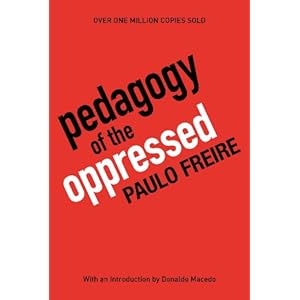Daniel Schipani, a Christian educator, draws on Friere and others when he seeks to articulate the goal of liberative Christian education as “sponsoring human emergence in the light of the reign of God” (26). As such, Christian education seeks to serve as a midwife for the full flowering of humanity and the divine dream that all would comprehensively fulfill the commandment to love God and neighbor. This comprehensiveness includes the ethical and political dimensions of human society.
A key concept for both Schipani and Friere is “praxis,” which Friere defines as “reflection and action upon the world in order to transform it” (Freire 51). As noted above, the starting point of liberation is the discovery oneself as a Subject, but this new knowledge “cannot be purely intellectual but must involve action; nor can it be limited to mere activism, but must include serious reflection: only then will is be a praxis” (Friere 65). According to Schipani, Christian education “emerges from Christian praxis” as faith working through love and precipitating further praxis (34).
For Schipani, theological themes enrich his understanding of the growth outcomes of Christian education. First, growth is acquiring the vision of God so that one may “see reality with the eyes of God” (30). Prayer and worship assist in developing an awareness of God’s presence and activity in the world. Growing in Christlike virtue is another theme for liberative Christian education since this entails becoming more human and thus being freed to treat others with the love, compassion, generosity that all humans deserve (31). Strengthening ones vocation in the Spirit is the third dimension of Schipani’s discipleship schema, and it “gives coherence and larger purpose” as instruments for the service of God, love of neighbor and care of the earth (31).
Under the larger banner of Christian education for social transformation, Schipani identifies several practical approaches. Among these is Friere’s conscientization, several features of which are worth noting. Developing the potential for critical reflection is key to becoming a Subject, for Friere. The primary educative practices meant to cultivate critical reflection on the nature of culture and reality include posing real-life problems and dialogue. Conspicuously absent are didactic methods. In fact, Friere calls for reconceiving of teachers as teachers-students and students as students-teachers. This is no cavalier leveling, rather it is a thoughtful response to his analysis that the “banking” approach to education, in which the teacher is supposed to have knowledge to deposit within the (ignorant) students, is modeled after the ideology which governs the relation of oppressor to the oppressed. Thus the “banking” model reinforces the oppressive society and will be of no use to those seeking liberation so revolutionaries must resist the temptation to employ it lest theirs simply become a new administration of oppression. As Friere stresses at several points, the pedagogy of the oppressed requires of the teacher-student a substantial and enacted trust in the ability of the oppressed to reason (66).
Schipani notes several other approaches to liberative pedagogy, as well. Education for Peace and Justice depends on a “curriculum of service” which is, in fact, a process of conversion that takes place as learners are “touched” by victims of injustice and their advocates (35-36). Transformative Bible Study intentionally places Scripture in dialog with the concrete situations of those who suffer and the ministry of the faith community (36). The final technique that Schipani lifts up is Willful Contextual Dislocations which include “going and seeing” expressions such as cultural immersion mission trips and “welcoming” varieties such as receiving into the faith community or home those who are victimized or oppressed.
Central to all liberative pedagogies is the cultivation of contextual awareness. Students-teachers must increasingly be able to recognize the humanmade nature of reality through critical reflection born in conversation. Within the community of faith, this commitment manifests in nurturing an “alternative way of seeing life and reality” that leads to “an alternative way of being” and an “alternative way of living” that, it is hoped, can expand the vision and imagination of others (Seymour 40).
My visit to Kibera, did nothing to “liberate” my hosts; nothing to raise their level of conscientization. But it was no-less a liberative moment, because not only were we with one another, but I began to reflected critically on reality in a new way. When I came home from that trip, I inexplicably changed my major and career trajectory so that I could serve the church. I had experienced grace—God’s power doing for me what I could not do myself. And those honorable impoverished Kenyans had demonstrated, in some small way, what Freire saw when he wrote “the oppressors, who exploit, and rape by virtue of their power, cannot find the strength to liberate either the oppressed or themselves. Only power that springs from the weakness of oppressed will be sufficiently strong to free both” (44).
Friere, Paulo. Pedagogy of the Oppressed: 30th Anniversary Edition. Continuum Press: 2000.
Seymour, Jack, Ed. Mapping Christian Education: Approaches to Congregational Learning. Abington Press: 1997.



This comment has been removed by a blog administrator.
ReplyDeleteThis comment has been removed by a blog administrator.
ReplyDelete